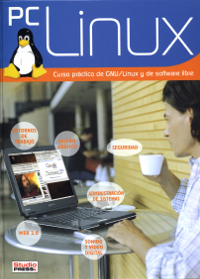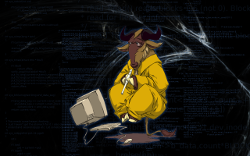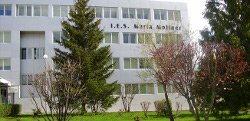

This is the story of my relation with the GNU/Linux's world.
On how I heard for the first time the word “Linux”

I was in my third o fourth year of the Geology degree I studied (2001-2002). At that time, we had to choose a few subjects out of our faculty. I met, in a biology subject, people from many different degrees, among them a very friendly guy who was studying IT. I remember that, one day, when we already had some confidence, I asked him: when are you going to invent a really good operative system? And he answered me: that already exists, it's called Linux. It was the first time I heard that term.
I began looking for information about it. The truth is that I didn't understand very well where Linux came from, but it was something that attracted me.
Going off the rails

Some months later, I found by chance in a book's street market a copy of a Red Hat book. It was a thick book, a good handbook, and there was a cd included with the system ready to be installed. At the book's street market it cost about 3 euros, because it was published some years before. It was one of those street markets where very cheap books are sold.
Several days later I decided to install it in my laptop. The handbook included instructions for the installation process with screenshots. It seemed easy.
Nevertheless, the installation process was interrupted at a particular moment because the system couldn't find a proper driver for some hardware components of the laptop, the graphic card among them. Result: it was a laptop incapable of getting started with any operative system. Solution: formatting and reinstalling the original system from the manufacturer's cd. Losses: a week and a half of work that I had to do again. Fortunately that wouldn't happen to me nowadays. What a start!
Those who understand know more than those who guess right
The explanation of what happened, in fact, is simple. And the whole trouble was the result of my lack of awareness.

First of all, you have to make backups of you data before carrying out any potentially dangerous process, such as the installation of a second operative system. I could have also recovered my data in other way (extracting the hard drive from the laptop, or using a Live CD), but at that time I had no idea about that.
Secondly, that Red Hat's cd wasn't a Live CD. This means that it didn't allow us to check the system loading it in the principal memory before installing. Today that wouldn't happen using a Live CD of any distribution. The book of Red Hat I bought was published 5 years before I bought my laptop. Therefore, it was impossible that it included the proper drivers for the hardware of my laptop, which were launched to the market 5 years before.
So the fault was entirely mine as I didn't understand what I was doing and because I didn't have backups of my data. Or, at least, because I didn't make a backup before trying to install another operative system.
With order and patience
After that unsuccessful attempt to try that mysterious Linux, I saw one day a special magazine about Linux (PC Linux) on a kiosk which advertised a practical course on GNU/Linux and Free Software collectible installments (that was the first time I saw that term "GNU"). Of course, I bought the first number, and after looking at the index of contents, I decided that I was going to buy the rest of the numbers.

I still have the whole bound manual by my side while I'm writing these lines, using a GNU/Linux distribution and LibreOffice 4, by the way.
Those installments allowed me to try a version of Ubuntu in my computer successfully, without any problem. And what is more important, I could understand how some things should be done. Or at least, I began to understand it.
Since then and until mid-2011 I kept trying new things in my free time, that is, when I felt like knowing more things or when I read news about a free program and I wanted to try it.
During that same time, while I was working for different geology companies, I learnt how to use a wide variety of programs: office suites (in a more advanced way), vector editors, Geographic Information Systems, programs used to generate Digital Elevation Models, etc.
Close windows to open doors

From the second half of 2011 I had much more free time, unfortunately. Although I have been always studying different things, I still had some free time, so I deepened my understanding of GNU/Linux: its origin, its fascinating history. Above all, I could see the applications of Free Software in public administrations and, of course, in the public education system. For this reason, I offered a talk on Free Software to the Youth Club of Segovia (the town where I live). Fifteen people attended to that talk. Most of them had never heard anything about Linux, or GNU, or how Free Software is advantageous in many aspects.
That was the first one of the talks I have been delivering. Some of them focused on the role of Free Software in public education, where there will never be reasonable excuses that justify the use of private software or, even worse, its piracy.
A step forward

A few weeks later, I realized that after years entrusting my doubts to the Internet, it was difficult to go much deeper into the knowledge of the administration of GNU/Linux. So I decided to enrol on a Systems Administration official course (Administration of IT Systems on Nets, in an approximate translation into English) in a high school in Segovia.
After two very intense years of studying, I graduated in IT Systems Administration with excellent marks. I obtained an (click to see the marks certificate). average mark of 9,54 point (out of 10) (click to see the marks certificate).
Currently
On 6 May 2017, I participated as a speaker in the Linux&Tapas event in the city of León with a talk on big data and privacy titled "The tale of the goose of the golden data" (in Spanish) continuing with an outreach work with which I feel very committed.
On 12 June 2018, I gave a conference on "PROFFESIONAL SECRET AND TECHNOLOGICAL INCOMPATIBILITIES" in The Official College of Doctors of Segovia. You can see the blog entry about it here (Spanish): "¿Las tecnologías que utilizamos son compatibles con el Secreto Profesional?".
On 29 September 2018, I participated again in the Linux&Tapas event in this case with a talk on web analytics and Matomo. You can see the article in the blog here (Spanish): "Analítica web con Matomo".
On 29 October 2018, I gave a conference on privacy titled (Spanish) "Privacidad: del grifo que gotea al Amazonas", in the Informatics Engineering Department of the Valladolid University (Campus María Zambrano, Segovia).
On 7 May 2019, I gave a conference on "PROFFESIONAL SECRET AND TECHNOLOGICAL INCOMPATIBILITIES" in the Offical College of Pharmacists of Segovia.
On 8 February 2020, I gave a conference titled "RELATIONSHIP BETWEEN BEHAVIOURAL ADDICTIONS, PRIVACY AND ISSUES DUE TO 'LEAKS' OF CLINICAL DATA" in the Rural Health Center of Segovia.
On 11 June 2020 I gave a conference through a webinar in colaboration with the association GNU/Linux Valencia and the company ValenciaTech about privacy titled "Privacidad: introducción al mundo presente".
Presently, I provide technical advice and training on various aspects related to Free Software, such as migration to Free Software, how to use GNU/Linux operative systems, recycling old computers or those which begin to run slowly, improving security and privacy, etc. Besides, I also offer some of these servicies on-line through video call, so I encourage you to contact me without obligation if you are interested in any of these subjects.
Currently I have some courses ready to deliver about GNU/Linux, Free software, free licenses, free educational resources, security and privacy for minors and IT security (in general).
If you want more information or make a comment please send me an email to info (at) pablomarinero (dot) com
For security reasons, especially to avoid SPAM, the email address has been altered. So, please replace the text (at) for @ and the text (dot) for . and, lastly, remove all blank spaces.
Sources of the external pictures:
 Linux text with funny tux face at openclipart.org
Linux text with funny tux face at openclipart.org
 Sad penguin at openclipart.org
Sad penguin at openclipart.org
 Bookworm penguin at openclipart.org
Bookworm penguin at openclipart.org
 Cover of the collectible "PC Linux. Curso práctico de GNU/Linux y de software libre. Studio Press".
Cover of the collectible "PC Linux. Curso práctico de GNU/Linux y de software libre. Studio Press".
 Wallpaper-gnu at wikipedia.org
Wallpaper-gnu at wikipedia.org
 Picture taken form the website of the María Moliner High School
Picture taken form the website of the María Moliner High School







